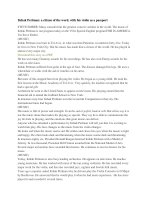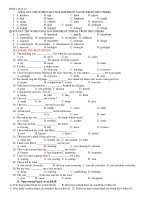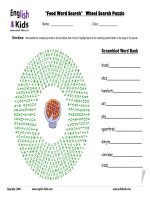LEXICOLOGY: THE WORD
Bạn đang xem bản rút gọn của tài liệu. Xem và tải ngay bản đầy đủ của tài liệu tại đây (654.8 KB, 7 trang )
LEXICOLOGY
UNIT 3: THE WORD
Different definitions of the word and their problems
+ 1st type of definition relies mainly writing traditions that separate by spaces
sequences of letters or characters.
These separations do not always correspond to functional realities.
+ 2nd type considers the indivisible unit of thought as the most essential criterion.
(a) the word as represented in writing represents a thought unit or psychological
unit.
(b) The word forms one block but includes two units of thought (farmer,
rethink, thoughtful)
(c) the psychological unit exceeds the limit of the graphological unit and
spreads over several words (all of a sudden, as usual)
+ 3rd type stems neither from writing traditions nor from thought units and relies
only on purely formal criteria.
3.1.2 Definition of word
“the word is considered as an uninterruptible unit of structure consisting of one or
more morphemes and which typically occurs in the structure of phrases.”
• Lexical and grammatical words:
Lexical words are nouns, verbs, adjectives, and adverbs
They have fairly independent meanings and may be meaningful even in isolation
or in a series. E.g. bottle has independent meaning and so does in a series boy,
break, bottle, stone. Lexical words open classes
Business English
Page 1 of 7
Grammatical words are elements like prepositions, articles, conjunctions, forms
indicating number or tense, etc. grammatical words closed classes
* There is no clear-cut dividing line between the two types of word
3.1.3 Characteristics of words
The word is an uninterruptible unit (other elements are added at the beginning or at
the end of the word).
The word may consist of one or more morphemes.
(simple words: free forms; complex words: one free form +one/more bound forms;
compound words: more than one free form)
The word occurs typically in the structure of phrases. Each word should belong to
a specific word class or part of speech.
3.1.4 Ambiguity in the notion of word
Sources of ambiguity:
+ the generic characteristic of the word
+ the multiplicity of aspects in every word
+ the lack of clear-cut boundaries in the non-linguistic world
+ the lack of familiarity with the referent of the words (Ullman, 1962)
A word can be regarded as „generic‟ when it has „abstract‟ reference, i.e. is more
schematic, poorer than particular words in its ability to distinguish specific
features.
E.g the word mammal is more generic and more abstract than cow. In the same
way animal is more abstract than mammal.
Business English
Page 2 of 7
The words we use are never completely homogenous in their meaning: all of them
have a number of facets or aspects depending on the context and situation in which
they are used and also on the personality of the speaker using them.
E.g. a table for two in a restaurant, the table of contents in a book, a multiplication
table at school.
The nature of the non-linguistic world may be a source of ambiguity.
Lack of familiarity with the „referent‟ of a word is a highly variable factor, since it
depends on the general knowledge and the special interest of each individual
E.g. Town dwellers will not be familiar with plant names or agricultural terms
which will be common knowledge for any gardener or farmer
3.2.1 The linguistic sign
The linguistic sign is a mental unit consisting of two faces, which cannot be
separated: a concept and an acoustic image
3.2.2 The word as a linguistic sign
Word meaning focuses on the relationship between the two faces of the signs, viz.
the acoustic image or „significant‟, i.e signifier, and the concept or „signifié‟, i.e.
the thing meant.
The denotation of a word is the core, central or referential meaning of the word
found in a dictionary. In English, a content word may have its denotation described
in terms of a set of semantic features that serve to identify the particular concept
associated with the word.
The connotation of a word is the additional meaning that the word has beyond its
denotaive meaning. It shows people‟s emotions and/or attitudes towards what the
word refers to.
Business English
Page 3 of 7
The denotation of a word can easily be found in a dictionary while its
connotation(s) may probaly depend on such factors as (1) the culture in which the
word is used; (2) the language user‟s family and/or educational background; (3) the
language user‟s social and/or political class; (4) the language user‟s speech
community and/or ethnic group; etc. In brief, these factors are by virtue of personal
and cultural associations.
A referent is an object or an entity in the real world or the world of your
imagination, e.g. your school, your classmates, your teacher, anything you can in
the classroom right now, the idealistic working conditions you have ever dreamed
of, etc. that is talked about.
The referent of a word is the relationship between that word and the thing it refers
to. (false)
The reference of a word or a linguistic expression is the relationship between that
word or expression and the thing (book), the action (read), the event (graduate
from university), the quality (sincerity), etc. it refers to.
Sense is a relationship between the words or expressions of a single language,
independently of the relationship which holds between those words or expressions
and their referents or denotata. (Lyons 1977: 206)
The sense of a word or a linguistic expression shows the internal relationship
between that word or expression and others in the vocabulary of a language.
e.g: A dog is chasing a cat has some sense. However, a dog is human has no sense.
Some words may have no specific denotation and still have sense. (e.g. unicorn)
3.3 Polysemy
Business English
Page 4 of 7
Polysemy: is a relation in which a single word has “two or more slightly different
but closely related meanings.
Words having one and the same form but different meanings are called
Polysemous words.
Metaphor is "the use of a word or phrase to indicate" something different from
(though related in some way to) the literal meaning, as in I'll make him eat his
words or she has heart of stone. [Crowther (ed), 1992:564]
Metaphor, metonymy and hyperbole are types of semantic change. (true)
3.4 Homonymy
Homonymy is a relation in which various words have the same (written and sound)
form but have different meanings.
e.g: seal - a sea animal - a design printed on paper by means of a stamp.
Ex: cellar – seller; you – ewe;
Homophony is a relation in which various words have the same sound form but
have different meanings and written forms.
e.g: hour - a twenty-fourth parts of a day and night
our - belonging to us
Homography is a relation in which various words have the same written form but
have different meanings and sound forms.
e.g: read - the bare infinitive form - the past tense form.
3.5 Multiword lexemes
Business English
Page 5 of 7
A lexeme or lexical item is a unit of lexical meaning, which exists regardless of
any inflectional endings it may have or the number of words it may contain.
(Crystal 1995 : 118)
In Multiword verbs: the main verb and one or two particles can be analysed as
constituents of a single unit.
Prepositional verbs are always followed by an object, they are all transitive (call
for, look at) . The object cannot occur between the particle and the main verb.
Phrasal Verbs may be followed by an object. (They can be transitive (bring up,
look up) or intransitive (give in, sit down).
Phrasal verbs can be separated, but prepositional verbs must not be separated.
phrasal-prepositional verbs: transitive, have two particles (check up on, get away
with).
Idioms: An idiom may be defined as a phrase, the meaning of which cannot be
predicted from the individual meanings of the morphemes it comprises.
E.g. „kick the bucket‟ (die)
I wanted to go to play outside, but it was raining cats and dogs yesterday. (raining
very heavily)
After many quarrelling years, the two political parties finally decided to bury the
hatchet. (to stop fighting or arguing or to end old resentments)
Linguistics has 3 main branches: syntax, semantics and pragmatics.
Syntax is the study of grammar (consisting of phonology, morphology, syntax and
textual grammar). Semantics and pragmatics deal with meaning. Semantics is the
study of meaning in language (i.e. what language means) while pragmatics is
Business English
Page 6 of 7
concerned with meaning in context (i.e. what people mean by the language they
use).
Lexicology is defined as the study of lexis (true)
The stock of words in a given language (Lexicon)
A network of associations which connect every word with other terms in a
language (assocative field)
Orthographic words are the concrete objects that we write.
Historical lexicology is the study of meaning, origin, and development of
individual words.
Business English
Page 7 of 7









